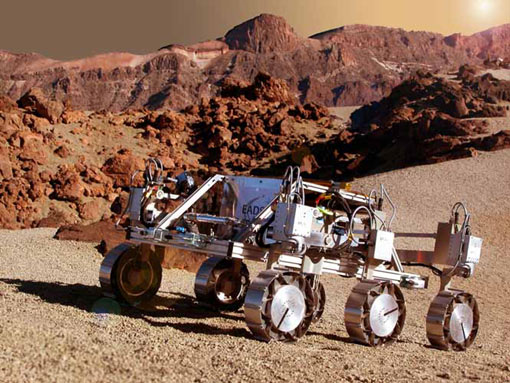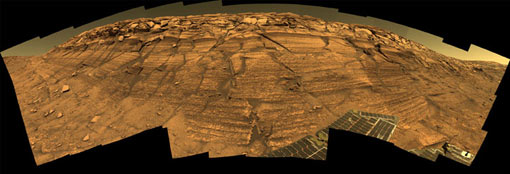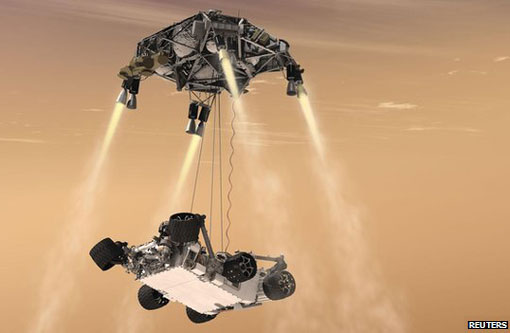You are hereAmazing! Spirit & Opportunity, Mars rovers (expected lifespan of 90 days from Jan 3 '04), roving on into 5 yrs /
Amazing! Spirit & Opportunity, Mars rovers (expected lifespan of 90 days from Jan 3 '04), roving on into 5 yrs

(quote)
The US space agency's (NASA) Mars rovers are celebrating a remarkable five years on the Red Planet. The first robot, named Spirit, landed on 3 January, 2004, followed by its twin, Opportunity, 21 days later. Their longevity in the freezing Martian conditions has surprised everyone.
The unmanned rovers Spirit and Opportunity are showing serious signs of wear after an astounding five years roaming Mars, U.S. space agency officials say. Scientists initially thought the remote-controlled machines would last only three months in Mars' freezing climate, said John Callas, rover project manager at the National Aeronautics and Space Administration's Jet Propulsion laboratory in Pasadena, Calif.

"These rovers are incredibly resilient considering the extreme environment the hardware experiences every day," Callas said, noting information sent by the rovers have proved water existed on Mars billions of years ago.
The twin Mars Exploration Rovers (MER) -- Spirit and Opportunity -- were designed to study the history of water on Mars at their landing sites and to uncover geologic clues about whether Mars had any environments wet enough in the past to have been hospitable to life. Spirit launched for the Red Planet on June 10, 2003, Opportunity followed on July 7, 2003, each blasting-off from Cape Canaveral Air Force Station. After nearly 7 months, Spirit landed at Gusev Crater on January 3, and Opportunity bounced to a stop in Meridiani Plaunum on January 24, Pacific Standard Time (PST).

The names Spirit and Opportunity were selected by NASA in a student essay contest that drew nearly 10,000 entries, sponsored by The Planetary Society. Larger than their toy-wagon size predecessor, Sojourner, the MER rovers are about the size of a small dune buggy. Each is equipped with a robotic arm that features a drilling tool, and three spectrometers, as well as four pairs of stereo cameras mounted in different positions on their frames, one of which allows them to have a human-like, 3-D view of the terrain. With the capability of traveling 100 meters a day, the MER rovers function as robot field geologists exploring the cold, barren Martian environment where humans cannot yet go.

By the end of April 2004, Spirit and Opportunity successfully completed their 90-day primary missions. Now, more than a year and a half after landing, the rovers continue exploring, gaining renown as one of the most remarkable Mars missions in space exploration history. From all cameras combined, the rovers have together returned more than 75,000 images so far, which, along with other geologic data from the rovers, have provided unprecedented evidence about wet environmental conditions in Mars' past.

Spirit is exploring a 150km-wide bowl-shaped depression known as Gusev Crater. It has found an abundance of rocks and soils bearing evidence of extensive exposure to water. Opportunity is on the other side of the planet, in a flat region known as Meridiani Planum. Some of the rocks seen by Opportunity were once "drenched" in water. Its data has shown conclusively that Mars sustained liquid water on its surface. The sedimentary rocks at its study location were laid down under gently flowing surface water.
No one knows how long the rovers will continue to operate. They are now showing some serious signs of wear and tear. Spirit has to drive backwards everywhere it goes because of a jammed wheel; and Opportunity's robotic arm has a glitch in a shoulder joint because of a broken electrical wire. There have been times also when the vehicles' have been dangerously short on power because of the dust covering on their solar panels.

*Update August 4, 2012*

After an eight-and-a-half month voyage through space, NASA's souped-up Mars spacecraft is zooming toward the red planet for what the agency hopes will be an epic touchdown.
The fiery punch through the tenuous Martian atmosphere at 13,000 mph (21,000 kph) on Sunday marks the beginning of "seven minutes of terror" as the Curiosity rover aims for a bullseye landing inside a massive crater near the planet's equator.
The latest landing attempt is more nerve-racking than in the past because NASA is testing out a new routine. Curiosity will steer itself part of the way and end on a dramatic note: Dangling by cables until its six wheels touch the ground.
NASA's Curiosity rover set for landing on Mars
Curiosity was launched from Earth back in November and is now near the end of its 570-million-km journey across space. The rover needs to hit a specific target in a big crater, and to do that the machine must enter the atmosphere at a very precise point. It will be used to study the rocks inside Gale Crater, one of the deepest holes on Mars, for signs that the planet may once have had life on it. Full of robotic tools to brush and drill into rocks, to scoop up, sort and sieve samples, Curiosity is the biggest, most sophisticated Mars rover yet. It is due to touch down at 06:31am GMT on Monday 6th August.
*Update August 6, 2012*
NASA rover Curiosity makes historic Mars landing, beams back photos
The one-ton, six-wheeled laboratory nailed an intricate and risky touchdown late on Sunday, much to the relief and joy of scientists and engineers eager to conduct NASA's first astrobiology mission since the 1970s Viking probes. "We trained ourselves for eight years to think the worst all the time," Curiosity lead engineer Miguel San Martin said. "You can never turn that off."
Mission control engineers at the Jet Propulsion Laboratory near Los Angeles erupted in cheers when confirmation was received that Curiosity, touted as the first full-fledged mobile science lab sent to a distant world, had landed on the Martian surface.
NASA engineers said the feat stands as the most challenging and elaborate achievement in the history of robotic spaceflight, and opens the door to a new era in planetary exploration. The landing also marked a much-welcome success and a major milestone for a U.S. space agency beset by budget cuts and the recent cancellation of its space shuttle program, NASA's centerpiece for 30 years.
The landing was a major initial hurdle for a two-year, $2.5 billion project whose primary focus is chemistry and geology. The daredevil nature of getting the rover to Mars captured the public's imagination.
DAREDEVIL DESCENT
Encased in a capsule-like protective shell, the nuclear-powered rover capped an eight-month voyage as it streaked into the thin Martian atmosphere at 13,200 miles per-hour (21,243 kilometers per hour), 17 times the speed of sound. Plunging through the top of the atmosphere at an angle producing aerodynamic lift, the capsule's "guided entry" system used jet thrusters to steer the craft as it fell, making small course corrections and burning off most of its downward speed.
Closer to the ground, the vessel was slowed further by a giant supersonic parachute before a jet backpack and flying "sky crane" took over to deliver Curiosity the last mile to the surface. The rover, about the size of a small sports car, came to rest as planned at the bottom of a vast, ancient impact bowl called Gale Crater, and near a towering mound of layered rock called Mount Sharp, which rises from the floor of the basin.
A trio of orbiting satellites monitored what NASA had billed as the "seven minutes of terror," but the anxiety proved to be unfounded. From an orbital perch 211 miles away, NASA's sharp-eyed Mars Reconnaissance Orbiter snapped a stunning and serene picture of Curiosity gracefully riding beneath its massive parachute en route to Gale Crater, located near the planet's equator in its southern hemisphere.
At 10:32 p.m. PDT on Sunday (1:32 a.m. EDT on Monday/0532 GMT on Monday) flight controllers at JPL received the equivalent of a text message from Curiosity that its journey of 352 million miles (566 million km) had ended safely. Seven minutes later, the rover transmitted a picture, related by another Mars orbiter called Odyssey, showing one of Curiosity's wheels on the planet's gravel-strewn surface.
(unquote)
Photos courtesy of NASA / JPL-Caltech / Maas Digital, The Onion, robotics.youngester.com, NASA / JPL / Cornell, NASA / JPL-Caltech, and Reuters
Original Source: Science News, The Planetary Society, and BBC
Related Articles: Inflatable Robots to visit Mars and Mars Rover Beginning To Hate Mars - Unmanned Vehicle 'Bored Out Of Its Mind'
Reply








